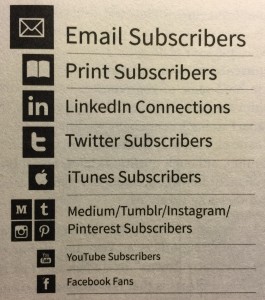
Who Matters Most to Your B2B Content Marketing?
And which channels are most effective for B2B content marketing?
The whole purpose of content marketing is to build an audience for your content. Joe Pulizzi crystallizes that idea in his new book, Content Inc.
The need to build an audience raises 2 key questions for B2B marketers:
• Who are the most valuable people in content marketing?
• Which content marketing channels work best to reach them?
For content marketers, the most important people are your subscribers, your best prospects, the people likeliest to become future customers.
Here’s the kicker: Not all subscribers are created equal. As you study the universe of your subscribers, you’ll find that some are more valuable than others.
Content Inc. offers a useful subscription hierarchy, ranking content subscribers this way:

To me, this hierarchy of subscribers makes a lot of sense because:
• It guides you on where to begin your content marketing.
• If you’re already doing content marketing, it suggests where to consider building next.

This hierarchy fits my content marketing experience at Tellabs, where we found email and print subscribers to Insight magazine 20% more responsive than other customer lists.
The top of the subscriber hierarchy reflects the content you control.
For instance, you have 100% control of your content in your blog, in your print publications, on LinkedIn, SlideShare, Twitter, RSS, and iTunes. You begin to lose control with YouTube, which may hold back some of your videos if subscribers don’t engage with them (known as subscriber burn).
You have very little control over Facebook, since Facebook’s algorithm suppresses overtly promotional posts. In fact, some companies report that Facebook posts reach only 1% of their followers.
The top of the subscriber hierarchy also reflects the subscribers you know. Certain channels provide your subscribers’ identity – and a way for you to contact them individually. Others don’t.
Of course you know your event attendees, email and print subscribers, LinkedIn connections, SlideShare and Twitter followers. On these platforms, you can identify individuals and communicate one-on-one.
But just as you don’t know all your website visitors, it’s not so easy to find out your followers’ identities on other platforms.
For a deeper insight into B2B content marketing, I mashed up the Content Inc. subscriber hierarchy with the 2016 B2B Content Marketing study from the Content Marketing Institute. I built a subscriber/effectiveness matrix, modifying the Content Inc. subscriber hierarchy by:
• Adding the content channels that B2B marketers use most, including events, RSS and Google+
• Examining the content channels that B2B marketers consider most effective
• Calculating the gaps between usage and effectiveness; smaller gaps are better.
Then I ranked the content channels that are most effective to help you reach your most valuable B2B subscribers:
1. Event attendees
2. Email subscribers
3. Print subscribers
4. SlideShare followers
5. LinkedIn followers
6. Twitter followers
7. RSS subscribers
8. YouTube subscribers
9. Facebook followers
10. Google+ followers.
Note: These final ranks are based on the matrix, with slight modifications based on experience. This ranking fits with what I hear from other B2B marketers – many of whom observe that events work best, SlideShare is vastly under-utilized, and Facebook is often overrated. Google+ is being killed off.
If you’re just starting out in content marketing, build on owned ground such as your blog. Small businesses with blogs are much more effective than those without.
Promote your content on leased ground such as social media. Collect subscribers’ emails, names and contact information – they hold tremendous value.
While you can be successful by building on leased ground such as LinkedIn, Twitter, Facebook and YouTube, you’ll be subject to the whims and caprices of big social media companies.
When other people control your channels, they can change the rules of the game in an instant and put you out of business. They may not distribute your content – unless you pay. They may even assert ownership and/or control of the content you’ve posted, as Facebook has.
While you may own your content, your website, your blog, and your list of subscribers, you can never own a subscriber. Subscribers can opt out at any time. It’s up to you to deliver useful, newsworthy, insightful content to hold on to subscribers.
Since content marketing is never a one-size-fits-all endeavor, apply these findings with care and judgment. As I work with clients, I often find compelling reasons to use channels that rank lower in these hierarchies.
When those reasons spring from insights about competitors and customers, based on competitive content audits and buyer persona research, I follow the data. But when I lack insights into competitors and customers, I use these hierarchies as a starting point.
Disclaimer: I like to play with data as I did above, but I’m no analyst. So feel free to poke holes in it and help me improve this model for the future. Share your comments and input with me at George@crystalclearcomms.com.
Contact Us





